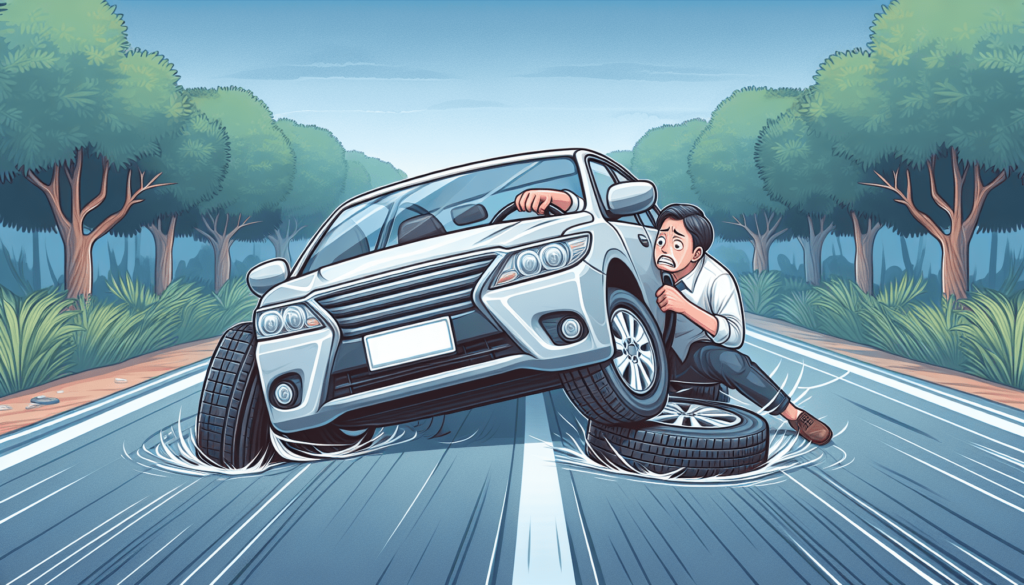Misaligned wheels may seem like a minor inconvenience, but the risks they pose can have a significant impact on your driving experience. From decreased fuel efficiency to uneven tire wear, driving with misaligned wheels can lead to expensive repairs and compromised road safety. In this article, we will explore the potential dangers of driving with misaligned wheels and why it’s crucial to address this issue promptly. So, buckle up and let’s hit the road to uncover the risks that lie ahead! Driving with misaligned wheels can have several negative consequences for both your vehicle and your overall driving experience. It is important to understand the signs of misalignment and the potential risks associated with it in order to take appropriate action and ensure your safety on the road. In this article, we will explore the various signs of misaligned wheels, the safety risks it poses, the mechanical and tire issues it can cause, the financial costs involved, the effects on vehicle performance, the impact on tire life, the consequences on the suspension system, the increased driver fatigue it can lead to, the environmental impact, and finally, the importance of regular wheel alignment in mitigating these risks.
Signs of Misaligned Wheels
One of the most prominent signs of misaligned wheels is uneven tire wear. If you notice uneven tread wear on your tires, such as more wear on one side than the other, it is important to get your wheels aligned as soon as possible. Another common sign is when your vehicle consistently pulls to one side while driving. This can make it difficult to keep your vehicle on a straight path and requires constant adjustments to the steering. Additionally, if you experience vibrations in the steering wheel while driving, it may indicate misaligned wheels. Lastly, having an off-center steering wheel when driving straight is another indicator of misalignment.
Safety Risks
Driving with misaligned wheels poses several safety risks that can affect your handling and control of the vehicle. When your wheels are misaligned, it becomes harder to steer your vehicle accurately, which can greatly impact your ability to maneuver and avoid obstacles on the road. Misaligned wheels also increase your braking distance, meaning it takes longer for your vehicle to come to a complete stop. This can be very dangerous in emergency situations where quick stopping is necessary. Moreover, misaligned wheels can lead to tire blowouts, which can cause sudden loss of control of the vehicle, especially at higher speeds. Finally, misalignment reduces the traction between your tires and the road, increasing the risk of skidding or hydroplaning in wet or slippery conditions.

Mechanical and Tire Issues
Misaligned wheels can result in various mechanical and tire issues that can affect the overall performance and longevity of your vehicle. The uneven tire wear caused by misalignment not only causes the tires to wear out faster but also affects the overall suspension and component wear. When the suspension is forced to compensate for misaligned wheels, it can lead to premature wear and tear of these components. Furthermore, misalignment can put added stress on the steering and suspension components, potentially causing damage and the need for expensive repairs. Another consequence of misalignment is increased fuel consumption, as the vehicle has to work harder to overcome the resistance caused by the misaligned wheels.
Financial Costs
The financial costs associated with driving with misaligned wheels can add up quickly. Frequent tire replacements become necessary due to the uneven wear caused by misalignment. Premature tire wear is another issue that can result in the need for early tire replacements. Additionally, misalignment can lead to uneven suspension wear, which can require expensive repairs to restore the proper functionality of the suspension system. Moreover, regular wheel alignments are necessary to correct misalignment, and these services can incur recurring expenses. Lastly, the increased fuel consumption resulting from misalignment can lead to higher fuel expenses over time.

Effects on Vehicle Performance
Misaligned wheels have a direct impact on the performance of your vehicle. They can result in reduced handling and stability, making it more difficult to control the vehicle, especially at higher speeds or in emergency situations. The impaired steering response also affects your ability to steer the vehicle with precision, increasing the likelihood of veering off course or reacting too late to potential dangers. Misaligned wheels can cause uneven braking performance, which can compromise your ability to safely and effectively bring your vehicle to a stop. Additionally, the vibrations and noise experienced when driving with misaligned wheels can negatively impact the overall driving experience and comfort. Lastly, misalignment reduces fuel efficiency, leading to decreased mileage per gallon and increased fuel expenses.
Impact on Tire Life
Misaligned wheels can significantly impact the lifespan of your tires. The uneven tire wear caused by misalignment not only necessitates more frequent tire replacements but also reduces the overall lifespan of the tires. The loss of tread due to misalignment increases the risk of tire failure and blowouts, posing a safety hazard on the road. Moreover, the need for regular maintenance to address misalignment and its effects on tire life can add to your maintenance costs over time.

Consequences on Suspension System
The suspension system of a vehicle is responsible for absorbing shock and providing a smooth and comfortable ride. However, misaligned wheels put added stress on the suspension components, forcing them to compensate for the misalignment. This can result in alignment issues within the suspension system itself, leading to further misalignment and premature wear and tear. Ultimately, this can result in the need for expensive repairs to restore the proper functionality of the suspension system, impacting your financial commitments.
Increased Driver Fatigue
Driving with misaligned wheels can greatly increase driver fatigue. Constant steering corrections are required to compensate for the misalignment, resulting in a tiring driving experience. The poor stability of the vehicle also puts added mental and physical strain on the driver, making it more challenging to maintain full control of the vehicle. These factors combined can lead to increased fatigue while driving, reducing your overall alertness and potentially increasing the risk of accidents.

Environmental Impact
Misaligned wheels have an environmental impact as well. The increased fuel consumption resulting from misalignment leads to higher carbon emissions. As the vehicle has to work harder to overcome the resistance caused by the misaligned wheels, more fuel is burned, contributing to environmental pollution. By addressing wheel alignment issues promptly, you can help reduce your carbon footprint and contribute to a cleaner and greener environment.
Importance of Regular Wheel Alignment
Given the numerous risks and consequences associated with driving with misaligned wheels, it is crucial to prioritize regular wheel alignment. By aligning your wheels regularly, you can prevent safety risks, such as decreased handling and control, increased braking distance, tire blowouts, and loss of traction. Regular alignment also extends the lifespan of your tires, reducing the need for frequent replacements and minimizing maintenance and repair costs in the long run. Moreover, proper wheel alignment improves your vehicle’s performance, ensuring optimal handling, stability, steering response, braking performance, and fuel efficiency.
In conclusion, driving with misaligned wheels can have a significant impact on your safety, vehicle performance, tire life, suspension system, and overall driving experience. It is important to be aware of the signs of misalignment and the risks it poses in order to take the necessary action. Regular wheel alignment is essential to prevent safety risks, extend tire life, improve vehicle performance, reduce maintenance and repair costs, and enhance fuel efficiency. By prioritizing wheel alignment, you can ensure a safer, smoother, and more cost-effective driving experience.


